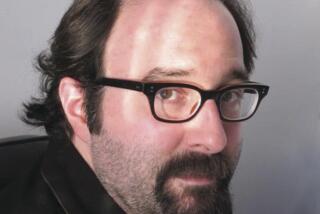Perspective: Back to the Future Day: What the franchise sneakily got right
- Share via
Many seismic events have shaken the world in the past 30 years -- the fall of Communism, the rise of the Clintons and Bushes, the invention of the iPhone, the realization that suspenders are a bad look for anyone under the age of 70.
One constant, however, has been “Back to the Future.” The 1985 Robert Zemeckis teen adventure -- and to a lesser degree, its two sequels -- has endured the test of pop-cultural time. A lot of great movie characters have come along over the years. Few remain standing like Michael J. Fox’s desperate-but-wry Marty McFly.
Ronald Reagan invoked the franchise in his 1986 State of the Union address. Andy Samberg made a reference to it in the opening of his Emmys speech this year. Seemingly nothing was lost -- or no time had passed -- in the interim.
SIGN UP for the free Indie Focus movies newsletter >>
At the risk of engendering some elder eye-rolls, “Back to the Future” has become a touchstone for Generation Xers (and, if a very informal survey is to be believed, for millennials too) in much the same way “The Graduate” has to baby boomers and “The Best Years of Our Lives” to the WWII generation. Walk into any room of film fans under the age of 45 and reel off the memes: “Great Scott!” “I’m your density.” The Enchantment Under the Sea dance. “Think, McFly, think.” 1.21 Gigawatts. “You’re just too darn loud.” You will soon be greeted with knowing, conspiratorial smiles. (This will also, incidentally, be the only time you can score cool points for citing a Huey Lewis cameo.)
It doesn’t usually pay to analyze cultural longevity. Some hit movies fade and others stick around. Any attempt to decipher the underlying factors is about as fruitful as scrutinizing the physics of a flying DeLorean.
Yet there are occasions when it might be OK to try, when it might be worthwhile to decode why some entertainment can be consumed anytime, anywhere, with the same enjoyment as when one first experienced it -- say, at an upstate New York mall on a summer-camp trip 30 years ago.
Movie fans on Wednesday are marking Back to the Future Day -- Oct. 21, 2015, that date, once seemingly so far away, that Marty and Doc land on in the second film.
One isn’t typically supposed to deconstruct life’s pleasures -- as with piecing together a torn-up letter, it might endanger our very existence. Yet when I thought about the holiday, and the ways the franchise continues on, with costume parties and concerts and cinema showings, I thought about what it meant that it was still around, what it was saying. And I figured, what the hell?
In breaking down the movie’s appeal, there are, of course, the glossy plot elements. The sci-fi conceit. The parallel multi-generational romances. The ticking clock that has the heroes trying to catch, literally, a bolt of lightning.
“You just have a masterfully written script in terms of tightness,” said Alan Silvestri, the film’s composer, who has been touring the world this year with that concert, when I asked him for his explanation of the movie’s abiding popularity. “Just the way it’s cut, the way it all fits together -- it’s exactly right.” (The WGA agrees: In 2006 it ranked “Back to the Future” the 56th best script of all time.)
The unlikely mix of wholesome and subversive doesn’t hurt either, even if that was the movie’s early undoing. (When Zemeckis and co-writer Bob Gale first pitched the idea for “Back to the Future” in Hollywood, they ran into a wall. Some studios thought it wasn’t hard-edged enough for an audience schooled in “Revenge of the Nerds” and “Porky’s.” Then Disney rejected it because it was too hard-edged.)
‘Back to the Future’: Bob Gale on the film’s legacy

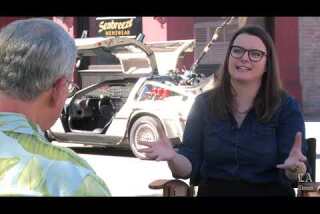
'Back to the Future': Newspapers
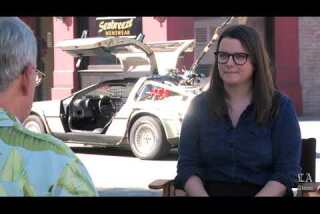
Back to the Future: Long road to making the film
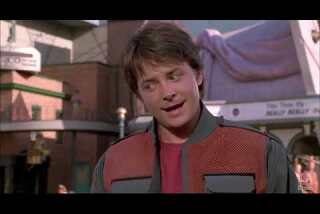
'Back to the Future': Hoverboard
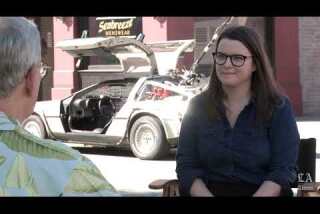
Back to the Future: Hiring Michael J. Fox
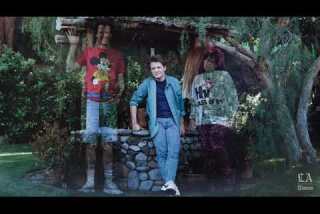
'Back to the Future': The disappearing McFlys photo
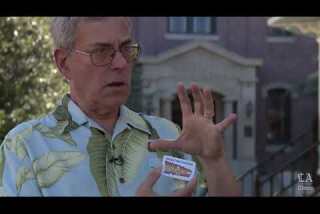
'Back to the Future': Alternate movie pins
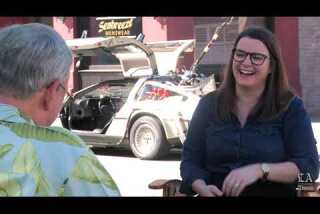
'Back to the Future': Grays Sports Almanac
The film also carries with it a playfully obdurate disregard for authority -- of the youthful sort, with Marty’s guitar-playing lateness in the face of a collar-grabbing principal, and of the more adult type, the out-of-the-box science practiced by Doc Brown. Movies about outliers tend to resonate because 90% of us think we’re better than average. Few films so skillfully exploit this self-perception better than “Back to the Future.”
But there’s something deeper at play, something that both makes the movie creepier on reflection and that could have made viewers (and, indeed, made a studio) stop dead in their tracks: the Oedipal element.
In watching Marty resist the overtures of Lorraine, we’re experiencing some darkly funny moments. But if the getting-hit-on-by-your-mother concept were just played for laughs it would amount to little more than a Freudian in-joke. “Back to the Future” does something else.
“You’re getting to be a fly on the wall when your parents got together, and isn’t that the great fantasy for many of us?” asked Gale, when I put the longevity question to him.
Deep down we all wonder where we came from, how two people very far removed from us came to make a choice that allowed us to even exist and have that thought in the first place. In “Back to the Future” we can see (as Gale, who came up with the idea of a maternal run-in, notes) just that process up close; in fact, we can be participants in it.
“I think if we didn’t give people a chance to see that it would have been a nice movie, a nice hit,” Gale said. “But it wouldn’t have lasted.” Is it an accident that the movie became such a Gen-X favorite? All of this parental archaeology plays extremely well to the first generation to experience divorce on a mass scale.
And, oh yes, then there’s the time travel. As it turns out, it’s not just happening on screen anymore. The Oct. 21, 2015, date allows us to play out the events of the movies from out there in the audience.
In the first two films, Marty first went back and then forward from his own time. As of Wednesday, officially, it’s a trip audiences can mimic. We can return to an earlier era by watching the first movie and recalling how we felt in 1985. Then we can zoom forward by watching the sequel and thinking how our own lives stack up -- a trip to an alternate future not unlike the one Marty creates for himself.
That latter phenomenon, and its attendant eerie prophecies and misfired predictions, has grabbed much of our attention ahead of Back to the Future Day. And why not? It’s fun to wonder why we don’t have self-tying sneakers, and what shoe campaigns Nike would come up with if we did. (“LeBron needs no laces?”) Ditto for hoverboards, which still don’t exist in an accessible way, no matter what articles like this tell you or what Wiz Khalifa says.
Kick it to 88 miles per hour and head to our enormous “Back to the Future” collection.
(It’s even fun to wonder, sort of, what it would have been like had Zemeckis, Gale and Steven Spielberg not convinced Universal to replace Eric Stoltz with Michael J. Fox a month into shooting, but that’s another matter.)
In all of these musings, there’s an air of disappointed melancholy -- what happened to the future Doc Brown promised us? We paid our movie tickets and we dutifully waited nearly three decades. Yet still no hoverboard.
Of course, fetishizing a future that didn’t happen is exactly what lends the movie its longevity. One big reason “Back to the Future 2” remains so enjoyable to watch is because of the ways it depicted a future that seems perpetually just out of reach. After all, the movie correctly foresaw plenty of other developments -- Skype, for one -- but those seem a lot less exciting.
Yet whether these embedded predictions in “Back to the Future 2” came true or not is beside the point. We may not have hoverboards, no one wears metallic glasses or shiny bespoke outfits (outside of a Daft Punk concert), and the Cubs may not be on the verge of winning the World Series (yet). But the franchise showcases a different shiny object (and one no less elusive): an understanding of our origins and an agency in shaping where they take us. Or, put another way, the present foreseen by “Back to the Future 2” may be less important than the ongoing past of “Back to the Future.”
Because for all the stonewashed jeans and Van Halen worship (and, oh yes, those suspenders), the 1985 of the movie doesn’t really feel fundamentally different from the world of today and its challenges and curiosities.
Many historical shifts have come along since 1985, sure. But “Back to the Future” has stayed with us because of the enduring truths it plays out in front of this backdrop. We still want to know exactly where we came from. And we still wonder whether, if we were there, we would have managed not to screw it up.
Mainly, though, we continue to be grateful that plutonium isn’t available at every corner drugstore. Yet.
Twitter: @ZeitchikLAT
ALSO:
Fan theories and plot speculation from the ‘Star Wars: The Force Awakens’ trailer
Marvel’s new series ‘Jessica Jones’ is not for kids, and that’s a good thing
As ‘Crimson Peak’ and ‘It Follows’ show, horror on film works on many levels
More to Read
Only good movies
Get the Indie Focus newsletter, Mark Olsen's weekly guide to the world of cinema.
You may occasionally receive promotional content from the Los Angeles Times.


